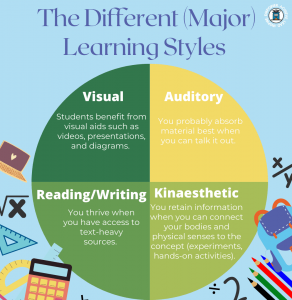Have you ever sat in class feeling as though you were paying attention, only to later realize that the information didn’t stick? If you’re a student, I’m sure you have, since we’re all only human—but if this occurs often, maybe you haven’t yet determined your learning style.
Understanding your learning style can help you avoid these situations. More importantly, recognizing your learning style can provide you with the necessary insight to more effectively absorb and retain information, and ultimately grow.
What is a learning style?
So, just what is a learning style? While this concept might seem pretty arbitrary, it’s actually quite straightforward. Learning styles are simply the different ways in which students most effectively learn. That is, learning style refer to each individual’s preferred approach to learning. This covers the different tools, methods, and strategies which students prefer in a learning environment.
If you have specific areas in school you’d like to work on (let’s be honest, who doesn’t?), recognizing the tools and strategies that help you learn can lead you to tap into your potential and excel.
If certain learning methods haven’t been working for you, there are various ways to seek new and better ways for you improve your academic performance.
Main learning styles
There are a number of different ways to learn, but the following approaches are the four major learning styles.
1. Visual learner
If you most easily absorb information through visual mediums—charts, diagrams, pictures, maps, etc.—you’re likely a visual learner. Visual learners learn best when they can spatially understand concepts. 
In the classroom, it’s important for these learners to have visual aids such as presentations, videos, homework, and worksheets. Try to save as many of these tools as you can, since they’ll be helpful when preparing for an exam.
When doing homework or studying for tests, it may also be beneficial for you to practice filling in diagrams or flowcharts themselves, as this is how you’ll be able to retain the information. You can also make great use of the internet, which offers tons of free educational resources where you’ll surely find visual resources.
2. Auditory learner
Auditory learners thrive in an environment where they can engage with information in a vocal manner. If you identify as an auditory learner, you learn best through reading out loud, open-lectures, and group discussions. You may often require lessons involving talking, since this is how you’ll best retain any concept.
If you’re an auditory learner, you usually best understand information when it involves speaking, hearing, and listening. You may have trouble absorbing and retaining information if you have to stay quiet for long periods of time.
In order to really drill in the information, you may want to discuss topics in groups (whether in or outside of the classroom), verbally go over concepts with your teacher, or learn through video/audio tools.
Don’t forget about mnemonic devices! A mnemonic device is a great tool that can help auditory learners recall certain information.
Example: Order of Operations (algebra)
| Parenthesis | Please |
| Exponents | Excuse |
| Multiplication | My |
| Division | Dear |
| Addition | Aunt |
| Subtraction | Sally |
3. Reading & writing learner
Students who learn best through written sources are reading and writing learners. If you align with this learning style, you may perform better when you have access to written information. This may include flashcards, textbooks, worksheets—basically, any material that’s text-heavy.
If you identify with this learning style, you can likely strengthen your understanding through reading or writing about concepts and definitions.
You may find it helpful to take copious notes in class, which can help you retain information. In addition, it might be useful to take notes while you study or read your textbook, and keep them to look back on. When reviewing for an exam, try writing out concepts and definitions to strengthen your recall ability.
4. Kinesthetic learner
Kinesthetic learners absorb information to the best of their ability through touch. This means that they thrive when their body is involved in the learning experience. 
If you have a kinaesthetic learning style, you probably benefit from lessons involving physical interactions, hands-on activities, and movement. You may learn best when using physical models/diagrams or participating in an interactive experiment.
Once you know that this is how you learn, you can mention to your teacher that you’d appreciate more hands-on activities. And many teachers will be thrilled to implement non-traditional days into their year! For instance, some science teachers like to do an activity where students create their own representation of the brain using candy or other materials.
As a kinesthetic learner, you may find that taking practice exams in an exam-like setting helps you absorb information and perform better. The reason for this is that your body will subconsciously remember the exam setting, & then you’ll feel more comfortable in that environment when the real exam rolls around.
Whether you’re trying to get through finals week, or just want to grow as a student, understanding your learning style can be beneficial, and in the end, help you succeed.
If you’re not sure how to go about identifying your learning style or think you might have tendencies that fall in multiple categories, you can utilize online resources.
If you book a session with My Private Professor, your tutor can work with you to understand and subsequently provide some insight about your learning style.
Author: Lydia Schapiro








